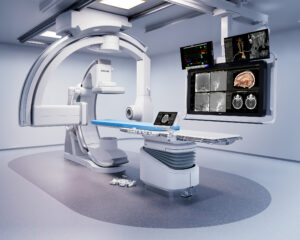
Royal Philips has announced major enhancements to its image-guided therapy system—Azurion—with the launch of its new Azurion neuro biplane system.
Featuring enhanced imaging and gantry positioning flexibility, this new angio suite system is designed to streamline neurovascular procedures and help care teams make the right decisions faster, treat more patients, and achieve better outcomes, the company says in a press release.
Minimally invasive procedures are a key part of the diagnosis and treatment pathway for stroke, where every minute counts in conserving patient quality of life, the release states. Interventional systems are also used to precisely plan and carry out complex neurovascular procedures, such as the repair of brain aneurysms and birth defects.
By allowing neurointerventionists to treat more patients, more efficiently, with potentially better outcomes, Philips’ new Azurion neuro biplane system is intended to enhance both staff and patient experience, and contribute to a lower cost of care.
“Working closely with leading interventionists, we designed the latest Azurion neuro biplane to meet their requirements of superior patient care, optimised angio suite performance, and efficient return on investment,” said Mark Stoffels, business leader of Image Guided Therapy Systems at Philips. “Together, I am confident we can continue to reduce the impact of stroke, helping more patients to recover faster and reducing long-term impact on their health.”
Philips’ Azurion neuro biplane image-guided therapy system is designed to smooth and optimise procedure workflows, where a combination of 2D and 3D imaging is needed for confident diagnosis, and precision treatment. Used with the company’s latest Neuro Suite software and services, it provides neurointerventionists with a fully integrated solution that combines Philips’ ClarityIQ low-dose imaging with a range of neuro-dedicated tools and value-added services that offer “unprecedented levels” of efficiency, flexibility, and control.
New features in the Azurion neuro biplane system include enhanced C-arm rotation, angulation (imaging angles), and parking facilities that allow rapid transitioning between 2D to 3D imaging, comprehensive table-side control that eliminates the need to leave the sterile field, automatic beam rotation to obtain correctly oriented images for every angulation and rotation, and a new head immobiliser to support enhanced stroke care.










